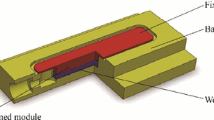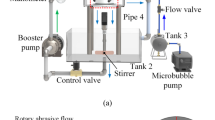Abstract
Tiny scale mold structural surface finishing is of high difficulty. In allusion to the problem, a new no-tool precision finishing method based on solid–liquid two-phase softness abrasive flow (SAF) is brought forward. By setting restrained component for the structural surface machined, the restrained flow passage is constructed. Using the wall effect of SAF, no-tool precision finishing for tiny scale structural surface can be realized. According to the Nikuradse’s experimental principles, the motion regulars of SAF are studied, and the friction coefficient formulas suited for SAF finishing are obtained. Taking U-shaped restrained flow passage as instance, standard k-ε model and Euler multiple-phase model are used to describe the SAF flow field, and the kinetic model of SAF is established based on discrete phase model. Then, the variation trends of SAF turbulent parameters and flow passage pressure distribution with different inlet velocities are acquired by semi-implicit method for pressure-linked equations consistent algorithm. Numerical simulation results derived that pressure attenuation of solid phase in flow passage is inversely proportional to inlet velocity, and the motion trails are disordered and stochastic, which are the sufficient conditions of SAF finishing. By analyzing pressure distribution and turbulent characteristics of SAF, the best finishing area in restrained flow passage is gained. Observational experiment of particles motion had been carried out; experimental results showed particles’ motion satisfied requirements of SAF finishing, and feasibility of SAF could be proved theoretically. SAF experimental platform oriented to module structural surface finishing is constructed, and the nano-level finishing can be realized. Experiment results show that SAF method can increase mold structural surface precision more than ten times, and the roughness machined in Ra value is less than 62 nm.
Similar content being viewed by others
References
Brinksmeier E (2004) Polishing of structured molds. CIRP Ann Manuf Technol 53(1):247–250
Brinksmeier E (2006) Finishing of structured surfaces by abrasive polishing. Precis Eng 30(3):325–336
Tang Y, Zhou DM, Yang G (2001) Machinability of abrasive flowing finishing. J SCTU 29(9):17–19
Tang Y, Zhou DM, Xia W (2001) Some investigation on the characteristic of wall sliding in abrasive flow finishing. J SCTU 29(1):34–36
Tzeng HJ, Yan BH, Hsu RT, Lin YC (2007) Self-modulating abrasive medium and its application to abrasive flow machining for finishing micro channel surfaces. Int J Adv Manuf Technol 32:1163–1169
Sunil J, Jain VK (2009) Rheological characterization of magnetorheological polishing fluid for MRAFF. Int J Adv Manuf Technol 42:656–668
Das M, Jain VK, Ghoshdastidar PS (2008) Analysis of magnetorheological abrasive flow finishing (MRAFF) process. Int J Adv Manuf Technol 38:613–621
Zhang XC, Dai YF, Li SY (2006) Analysis and design of magnetic field for MJP. Aviation Precision Manuf Tech 42(1):12–15
Jain VK, Adsul SG (2000) Experimental investigations into abrasive flow machining (AFM). Int J Mach Tools Manuf 40(7):1003–1021
Ji SM, Xiao FQ, Tan DP (2010) Analytical method for softness abrasive flow field based on discrete phase model. Sci China Technol Sci 53(10):2867–2877
Nikuradse J (1933) Laws of flows in rough pipes. VDI-Forchungsheft 361 B 4:361 (NACA TM. 1292)
Wang WM, Li DY, Hu J, Peng YH, Zhang YS, Li DY (2005) Numerical simulation of fluid flow and heat transfer in a plasma spray gun. Int J Adv Manuf Technol 26:537–543
Irani RA, Bauer RJ, Warkentin A (2005) A review of cutting fluid application in the grinding process. Int J Mach Tools Manuf 45(15):1696–1705
Launder BE, Spalding DB (1972) Lecture in mathematical models of turbulence. Academic, London
Annaland MVS, Deen NG, Kuipers JAM (2007) Multi-level computational fluid dynamics models for the description of particle mixing and granulation in fluidized beds. Handbook of Powder Tech 11(3):1071–1107
Kumar MM, Natarajan E (2008) CFD simulation for two-phase mixing in 2D fluidized bed. Int J Adv Manuf Technol. doi:10.1007/s00170-008-1875-9
Finnemore JE, Franzini JB (2006) Fluid mechanics with engineering applications. China Machine Press, Beijing
Liu YA, Huang ZY, Ji HF, Li HQ (2009) Solid volume fraction measurement of gas–solid two-phase flow based on terahertz time-domain spectroscopy technique: a preliminary study and static experimental results. IEEE Trans Instrum Meas 58(5):1585–1591
Li GM, Wang YS, Kang LQ (2008) Numerical simulation on solid particle movement characters of liquid–solid tow phase flow in sudden expansion pipe by discrete particle model. J Eng Thermo Phy 29(12):2061–2064
Peterson SD, Porfiri M, Rovardi A (2009) A particle image velocimetry study of vibrating ionic polymer metal composites in aqueous environments. IEEE/ASME Trans Mechatronics 14(4):474–483
Acknowledgment
The authors acknowledge the financial support provided by the National Natural Science Foundation of China (50875242, 50905163) and Natural Science Foundation of Zhejiang Province (Z107517, Y1090836). We also acknowledge the financial support of Key Laboratory of Special Purpose Equipment and Advanced Manufacturing Technology Ministry of Education in Zhejiang University of Technology.
Author information
Authors and Affiliations
Corresponding author
Rights and permissions
About this article
Cite this article
Li, C., Ji, SM. & Tan, DP. Softness abrasive flow method oriented to tiny scale mold structural surface. Int J Adv Manuf Technol 61, 975–987 (2012). https://doi.org/10.1007/s00170-011-3621-y
Received:
Accepted:
Published:
Issue Date:
DOI: https://doi.org/10.1007/s00170-011-3621-y




